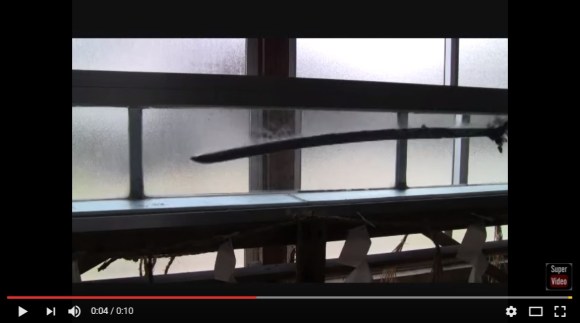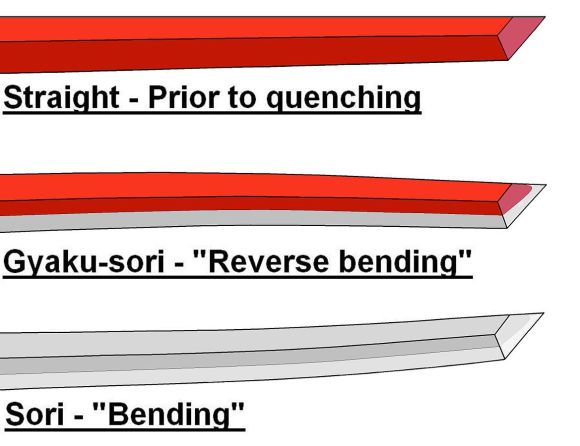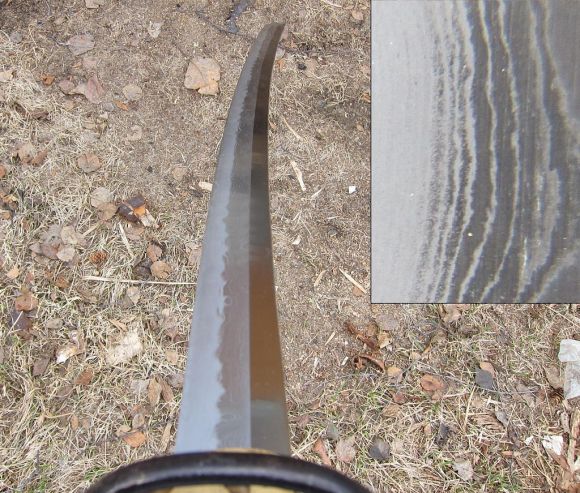
Forging a katana is extremely labor intensive, but it all comes together with a swift dunk in water to cool.
With hundreds of years of experience, the Japanese have swordsmithing down to an art, and the magnificence of the katana is proof of that. Like anything that is high quality, the process to make it is very labor intensive, with several stages of reheating and folding different metals together to create the perfect balance and strength in the blade.
Part of the process involves what is called differential hardening, or differential quenching, in order to create a blade that is well-balanced. Heating the sword until it’s red-hot and cooling it in liquid at different speeds results in a hard, strong cutting edge and a softer, resilient spine, which allows the blade to absorb shock without breaking. To accomplish this, the sword is painted with layers of clay before heating, with a thin layer or none at all on the edge of the sword, ensuring quick cooling to maximize hardening for the edge. As you can see in the video below, cooling the steel at different rates causes the blade to arch downward, before snapping back up into its final well-known curved state.
The diagram below also shows what happens during the quenching process. You can also see that quenching gives the sword a visible boundary between the hard and soft steel, as well as gives the sword its signature curve – two characteristics that Japanese swords have become known for.

▼ The visible “tempering line”, showing the divide between hard and soft steel.

With so much going in to each aspect of the sword, it’s no wonder katana and other nihonto (traditional Japanese swords) have become world-renown for their excellence.
Source and top image: YouTube/supervideo via Sploid
Reference: Wikipedia

 Real-life Rurouni Kenshin reverse-blade katana, forged by master swordsmith, now on display【Pics】
Real-life Rurouni Kenshin reverse-blade katana, forged by master swordsmith, now on display【Pics】 One Piece anime katanas recreated as exquisite letter openers by Japan’s swordsmith legacy heirs
One Piece anime katanas recreated as exquisite letter openers by Japan’s swordsmith legacy heirs Japanese samurai sword ice cream crafted by master swordsmith from famous katana town of Seki
Japanese samurai sword ice cream crafted by master swordsmith from famous katana town of Seki Genuine Muramasa blade and Muromachi katana on display at Tokyo’s Touken Ranbu store【Photos】
Genuine Muramasa blade and Muromachi katana on display at Tokyo’s Touken Ranbu store【Photos】 Legendary crescent moon katana, one of Japan’s Five Swords Under Heaven, now on display in Tokyo
Legendary crescent moon katana, one of Japan’s Five Swords Under Heaven, now on display in Tokyo Pizza Hut Japan’s hot lucky bags are perfect for a New Year’s pizza party
Pizza Hut Japan’s hot lucky bags are perfect for a New Year’s pizza party We found possibly the quietest Japanese-style hotel in Tokyo’s bustling Shinjuku district
We found possibly the quietest Japanese-style hotel in Tokyo’s bustling Shinjuku district Starbucks Japan ready to get Year of the Horse started with adorable drinkware and plushies【Pics】
Starbucks Japan ready to get Year of the Horse started with adorable drinkware and plushies【Pics】 7 great places to see Mt. Fuji from without having to climb it
7 great places to see Mt. Fuji from without having to climb it Design-your-own-Pokémon-T-shirt service launches at Uniqlo, dozens of species to work with【Pics】
Design-your-own-Pokémon-T-shirt service launches at Uniqlo, dozens of species to work with【Pics】 Green onion baths return to Japanese bathhouse to celebrate Labor Day
Green onion baths return to Japanese bathhouse to celebrate Labor Day Japanese thug wear from Birth Japan perfect for those breaking bad next year
Japanese thug wear from Birth Japan perfect for those breaking bad next year We make a Russian Kentucky Fried Chicken sushi ginger sandwich
We make a Russian Kentucky Fried Chicken sushi ginger sandwich The old-school awesomeness of the New Akao, a Showa-era hot spring hotel still standing tall
The old-school awesomeness of the New Akao, a Showa-era hot spring hotel still standing tall We slide down Osaka’s most famous tower and get free curry for it
We slide down Osaka’s most famous tower and get free curry for it 7-Eleven Japan’s ramen-cooking robot whipped us up a bowl of noodles【Taste test】
7-Eleven Japan’s ramen-cooking robot whipped us up a bowl of noodles【Taste test】 Cyberpunk anime meets traditional culture in Ghost in the Shell gold leaf Japanese changing screens
Cyberpunk anime meets traditional culture in Ghost in the Shell gold leaf Japanese changing screens Hello Kitty Choco Egg figures are an adorable trip through three periods of Japanese pop culture【Pics】
Hello Kitty Choco Egg figures are an adorable trip through three periods of Japanese pop culture【Pics】 Japan’s otoshidama tradition of giving kids money at New Year’s gets a social welfare upgrade
Japan’s otoshidama tradition of giving kids money at New Year’s gets a social welfare upgrade Lacquerware supplier to emperor of Japan and Pokémon team up for new tableware
Lacquerware supplier to emperor of Japan and Pokémon team up for new tableware Sumo Sanrio! Hello Kitty and pals team up with Japan Sumo Association for new merch【Pics】
Sumo Sanrio! Hello Kitty and pals team up with Japan Sumo Association for new merch【Pics】 Can a dirty butthole make you filthy rich in Japan? We’re starting a New Year’s lottery experiment
Can a dirty butthole make you filthy rich in Japan? We’re starting a New Year’s lottery experiment 7-Eleven Japan starts new temporary luggage storage service in over 300 branches
7-Eleven Japan starts new temporary luggage storage service in over 300 branches Disillusionment at Tsukiji’s tourist-target prices led us to a great ramen restaurant in Tokyo
Disillusionment at Tsukiji’s tourist-target prices led us to a great ramen restaurant in Tokyo Starbucks teams up with 166-year-old Kyoto doll maker for Year of the Horse decorations【Photos】
Starbucks teams up with 166-year-old Kyoto doll maker for Year of the Horse decorations【Photos】 Tokyo considering law requiring more trash cans following litter increase in heavily touristed area
Tokyo considering law requiring more trash cans following litter increase in heavily touristed area Tokyo’s Tsukiji sushi neighborhood asks tour groups to stay away for the rest of the month
Tokyo’s Tsukiji sushi neighborhood asks tour groups to stay away for the rest of the month Nintendo’s Kirby now delivering orders at Kura Sushi restaurants, but not in Japan
Nintendo’s Kirby now delivering orders at Kura Sushi restaurants, but not in Japan Tokyo event lets you travel back in time, for free, to celebrate 100 years since Showa era start
Tokyo event lets you travel back in time, for free, to celebrate 100 years since Showa era start Sanrio theme park in Japan announces plans to expand into a Sanrio resort
Sanrio theme park in Japan announces plans to expand into a Sanrio resort Japan may add Japanese language proficiency, lifestyle classes to permanent foreign resident requirements
Japan may add Japanese language proficiency, lifestyle classes to permanent foreign resident requirements Survey asks foreign tourists what bothered them in Japan, more than half gave same answer
Survey asks foreign tourists what bothered them in Japan, more than half gave same answer Japan’s human washing machines will go on sale to general public, demos to be held in Tokyo
Japan’s human washing machines will go on sale to general public, demos to be held in Tokyo Japan’s deadliest food claims more victims, but why do people keep eating it for New Year’s?
Japan’s deadliest food claims more victims, but why do people keep eating it for New Year’s? We deeply regret going into this tunnel on our walk in the mountains of Japan
We deeply regret going into this tunnel on our walk in the mountains of Japan Studio Ghibli releases Kodama forest spirits from Princess Mononoke to light up your home
Studio Ghibli releases Kodama forest spirits from Princess Mononoke to light up your home Major Japanese hotel chain says reservations via overseas booking sites may not be valid
Major Japanese hotel chain says reservations via overseas booking sites may not be valid Put sesame oil in your coffee? Japanese maker says it’s the best way to start your day【Taste test】
Put sesame oil in your coffee? Japanese maker says it’s the best way to start your day【Taste test】 No more using real katana for tourism activities, Japan’s National Police Agency says
No more using real katana for tourism activities, Japan’s National Police Agency says Starbucks Japan reveals new sakura drinkware collection, inspired by evening cherry blossoms
Starbucks Japan reveals new sakura drinkware collection, inspired by evening cherry blossoms Updated cherry blossom forecast shows extra-long sakura season for Japan this year
Updated cherry blossom forecast shows extra-long sakura season for Japan this year Sword enthusiasts, here’s the katana documentary you won’t want to miss! 【Video】
Sword enthusiasts, here’s the katana documentary you won’t want to miss! 【Video】 Sharpen your look with stylish Damascus steel watches modeled after Japanese blades
Sharpen your look with stylish Damascus steel watches modeled after Japanese blades An up-close look at one of Japan’s five Ryuseito swords, forged from meteorites【Photos】
An up-close look at one of Japan’s five Ryuseito swords, forged from meteorites【Photos】 Chop up paperwork with katana scissors inspired by the swords of Oda Nobunaga and other samurai
Chop up paperwork with katana scissors inspired by the swords of Oda Nobunaga and other samurai You can get a custom-made katana and a tax discount by donating to this Kyoto city【Photos】
You can get a custom-made katana and a tax discount by donating to this Kyoto city【Photos】 Swords of famous samurai reborn as beautiful kitchen knives from Japan’s number-one katana town
Swords of famous samurai reborn as beautiful kitchen knives from Japan’s number-one katana town Cool housewarming bonus: free Japanese katanas, potentially carved by a master craftsman
Cool housewarming bonus: free Japanese katanas, potentially carved by a master craftsman Real-life Rurouni Kenshin katana forged based on sword of series’ most merciless villain【Photos】
Real-life Rurouni Kenshin katana forged based on sword of series’ most merciless villain【Photos】 What’s so special about Japanese swords? We interview master katana maker Norihiro Miyairi!
What’s so special about Japanese swords? We interview master katana maker Norihiro Miyairi! Katana that shoot flames are real in amazing Japanese artist’s video series【Videos】
Katana that shoot flames are real in amazing Japanese artist’s video series【Videos】 Missing 700-year-old national treasure katana found in Australia【Video】
Missing 700-year-old national treasure katana found in Australia【Video】 Cruel angels, beautiful blades: The amazing sword of the Evangelion and Katana exhibition【Photos】
Cruel angels, beautiful blades: The amazing sword of the Evangelion and Katana exhibition【Photos】 This hotel has one of the coolest katana collections in Japan, and admission is totally free【Pics】
This hotel has one of the coolest katana collections in Japan, and admission is totally free【Pics】 “2D vs. Katana” exhibition shows off recreations of swords from anime and video games in Osaka
“2D vs. Katana” exhibition shows off recreations of swords from anime and video games in Osaka Katana of four of Japan’s greatest samurai turned into gorgeous scissors
Katana of four of Japan’s greatest samurai turned into gorgeous scissors
Leave a Reply